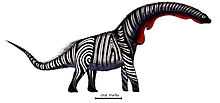Overosaurus
| Overosaurus Temporal range: Late Cretaceous, Campanian | |
|---|---|
 | |
| Scientific classification | |
| Kingdom: | Animalia |
| Phylum: | Chordata |
| Clade: | Dinosauria |
| Suborder: | †Sauropodomorpha |
| Clade: | †Titanosauria |
| Family: | †Aeolosauridae |
| Tribe: | †Aeolosaurini |
| Genus: | †Overosaurus Coria et al., 2013 |
| Type species | |
| †Overosaurus paradasorum Coria et al., 2013 | |
Overosaurus is an extinct genus of sauropod dinosaurs, containing only a single species, Overosaurus paradasorum. This species lived approximately 84 to 78 million years ago during the latter part of the Cretaceous Period in what is now Patagonia (in southern Argentina). Overosaurus paradasorum was relatively small compared with other sauropods from Patagonia, like the saltasaurids and other aeolosaurines.[1] It was a ground-dwelling herbivore, that could grow up to 8.6 m (28.2 ft) long.
Description
Overosaurus was first described and named by Rodolfo A. Coria, Leonardo S. Filippi, Luis M. Chiappe, Rodolfo García and Andrea B. Arcucci in 2013. This species is known solely from the holotype MAU-Pv-CO-439 which consists of a fully articulated vertebral series from the 10th cervical to the 20th caudal vertebra, the ribs of the last three cervical vertebrae, six right dorsal ribs (articulated with their respective dorsal vertebrae 2,3,4,5,8,9), five left dorsal ribs (articulated with their respective dorsal vertebrae 2,3,4,5,8), the proximal portions of dorsal ribs of both sides of dorsal vertebrae 9 and 10, a complete right ilium and a fragmented left ilium. Specifically the vertebral series includes the last four cervical vertebrae, ten dorsal vertebrae, six sacral vertebrae, and twenty caudal vertebrae. Its sacrum consists of six fused sacral vertebrae.[1]
Classification
Overosaurus was differentiated from other titanosaur taxa using a unique combination of characters present in the illium and in the cervical, dorsal and caudal vertebrae. A phylogenetic analysis of Lithostrotia placed Overosaurus within the Aeolosaurini, as the sister taxon of a monophyletic group formed by Gondwanatitan faustoi, Pitekunsaurus macayai, Aeolosaurus rionegrinus, and Aeolosaurus maximus.
Paleoecology
Provenance and occurrence
The only known specimen of Overosaurus paradasorum was recovered at the Cerro Overo locality in the Anacleto Formation of the Neuquén Group, in Patagonia, Argentina. The specimen was collected in 2002 by researchers from the Museo Carmen Funes, the Museo Argentino Urquiza, and the Natural History Museum of Los Angeles County, in terrestrial sediments deposited during the Campanian stage of the Late Cretaceous period, approximately 84 to 78 million years ago. This specimen is housed in the collection of the Museo Argentino Urquiza in Neuquén, Argentina.
References
- ↑ 1.0 1.1 Coria, R. A.; Filippi, L. S.; Chiappe, L. M.; García, R.; Arcucci, A. B. (2013). "Overosaurus paradasorum gen. et sp. nov. , a new sauropod dinosaur (Titanosauria: Lithostrotia) from the Late Cretaceous of Neuquén, Patagonia, Argentina". Zootaxa 3683 (4): 357. doi:10.11646/zootaxa.3683.4.2.